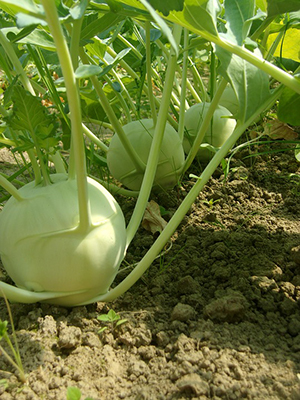Kohlrabi

If you’re not familiar with kohlrabi, you’re not alone. Kohlrabi isn’t just new to you; it’s new to the planet. This strange, sputnik-shaped vegetable has no historical record before 1554 AD. In the U.S. it was uncommon until the 1880s and rarely grown in the South. Recently, however, its popularity has skyrocketed. Once rare, this vegetable is now stocked in supermarkets around the country.
Kohlrabi’s cultivation began in northern Europe, a rarity in the vegetable world. Its name comes from two languages: German and Italian. Kohl means “cabbage” in German. Rapa is “turnip” in historic Italian. Thus “cabbage turnip,” a fitting name for this unusual vegetable. Because of its German roots it is also called “German turnip.”
Along with many other cole crops, kohlrabi is a member of genus Brassica. Common cole crops include cabbage, Brussels sprouts, broccoli, cauliflower, kale and more. Interestingly, these six vegetables are all considered one species. The botanical name for all of these is Brassica oleracea. To help distinguish them, scientists gave each a variety name (var.), added after the botanical name. Kohlrabi’s full scientific name is Brassica oleracea var. gongylodes.
Characteristics
Kohlrabi has an enlarged, bulb-shaped stem and small, sparse leaves. In the U.S. it comes in two colors: red and green. Red varieties may appear purple after harvest and green varieties, white. The color does not affect the growth or flavor. Both are well-suited to home gardens and home menus.
As a food, kohlrabi is high in dietary fiber and low in fat. Like all vegetables it contains some protein, but it is most valued for its vitamins. One cup of kohlrabi contains 93% of your daily value of vitamin C. It also contains more vitamin B6 and potassium than many cole crop cousins.
Planting and Care
Kohlrabi is a very productive cool-weather crop. It is easy to grow and matures quickly. Because of this, gardeners can grow multiple crops in one season. The planting time and methods are very similar to those of cabbage.
A number of kohlrabi varieties are available. ‘White Vienna’ is a popular choice in Florida. This variety can be harvested 55 days after sowing. Other varieties well suited for Florida include ‘Kolibri’ (red) and ‘Terek’ (green).
Seed kohlrabi directly into a garden or transplant young plants. Plants should be spaced about 4 inches apart. When possible, do not plant them near other cole crops. The concern is that these relatives share several common pests. Planting cole crops with rows between them will keep pests from spreading.
Harvest kohlrabi early and it will be tender and delicious. With age, however, the tissue becomes tough and fibrous. In your garden, harvest plants at about the two-month mark. Forty days is common for transplants, but seeds may require 60 days. Kohlrabi can also be grown as a microgreen. Harvest microgreen kohlrabi when four true leaves have emerged.
From the Garden to the Kitchen
Kohlrabi is a very versatile vegetable. The flavor of the bulb-like stem is similar to cabbage and turnips, though milder and sweeter. The young leaves are also edible and have a stronger flavor. Prepare these as you would kale or collards. The roots are edible but not usually eaten.
Before consuming kohlrabi stem tissue, use a peeler to remove the outer layer. From there the culinary options are endless! It is delicious seasoned and roasted or boiled and then mashed or puréed. Add the puree to a dip or make it into a creamy soup. Grated kohlrabi is fried into fritters or added raw to salads or appetizers. The crunchy, peppery flavor is popular in slaw recipes. Finally, steamed kohlrabi makes a nutritious addition to stir-fries, stews and casseroles.
For more information on growing kohlrabi, see the links below or contact your county Extension office.
